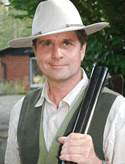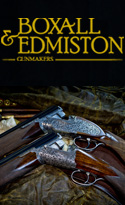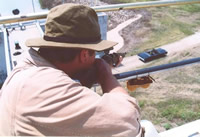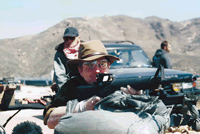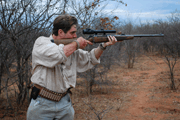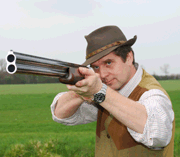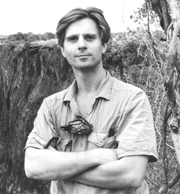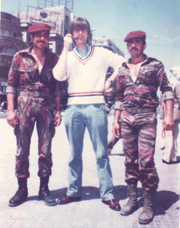Kennedy Assassination Latest
Well, I have been at it again - recreating the Kennedy assassination in Dallas for a Discovery Channel documentary. The more I look at this tragic incident, the more suspicious it all gets. Regular readers of this magazine may remember that some years back, I was also in Dallas on the Kennedy trail. On that trip, I proved that the shots could be made with the 6.5mm Mannlicher Carcano rifle allegedly used by Oswald and fitted with a cheap ‘tin-whistle’ 4 power telescopic sight.
I made them repeatedly (half a dozen times) in the required 7-8 second time frame firing from the correct height, at the correct ranges at a vehicle moving at the correct speed using an exact replica of the Oswald rifle and scope and identical ammunition. On the first run, I hit the head target as a crossing shot at about 45 yards (which apparently Oswald missed), I also connected on the next two shots at 60 plus 90 plus yards respectively. [We did the shooting on a specially built range at the levy in Dallas - where Oswald is believed to have practised for the shooting.]
The declared second shot - if you believe the Warren Commission official Report - was at an oblique angle (the famous magic bullet shot). It allegedly went through JFK’s back exited at his throat and went on to hit Governor Connally. The third shot - and many have suggested that there may have been more - was the killing shot where JFK’s head apparent is pushed back (leading to many suggestions that there was a second gunman positioned forward of the presidential cavalcade).
Here’s my bottom line from experience of using the weapon system. The Carcano is a poor gun, and the optical sight found upon it (as presented as evidence) was even worse - the sort of cheap thing with a moving reticule that was once used on air-rifles (I had something similar on my BSA Airsporter when I was a kid). The gun is up to the task, however - just. And, the shots with it are possible within the given time frame. I have made them again and again. Other reports not withstanding, I believe any competent rifleman would have had a good chance of connecting at least once.
That does not mean that Oswald himself shot on the day. I tend to think he did., though. But, I do not believe he was a ‘lone nut’. His background is deeply suspicious. Can we really believe a guy working as a radar technician on the U2 spy plane project - the most secret thing on the planet in the late 50s - was studying Russian and Marxism whilst he was in the Marine Corps? He then gives up on the American way and heads off to Moscow via London and Helsinki. He spends time in a Soviet mental institution, gets job in a sheet metal factory in Minsk and marries a KGB colonel’s daughter and is given a Soviet hunting license. He then becomes disenchanted with Marxist Leninist life, packs his bags and returns to Texas. Three weeks before the assassination he goes to Mexico City visits Russian and Cuban legations and shortly after gets the job in the Texas Book Depository.
I suspect, but cannot prove, that he was being run as someone’s agent on that fateful day in November 1963. It is also quite possible that there was a second (or third) gunman but it is hard to prove. There is, however, some compelling evidence for some sort of conspiracy beyond the mere fact that Kennedy’s head appears to move rearwards as the bullet impacts.
1) It is deeply suspicious that the only complete bullet (a round nose Winchester Western FMJ) was found intact and in near perfect condition on the trolley that Governor Connally had been on in the hospital - no bullet was removed from JFK, Connally, or the vehicle. Nor, was any other bullet found.
2) Various bullet fragments were however found. This of itself is deeply suspicious. One bullet is, all too conveniently, found intact - with no evidence of distortion whatsoever, just rifling marks. As well as this, a significant number of fragments are found in both Kennedy‘s and Connally‘s body.
It simply does not add up. FMJ bullets don’t tend to fragment when shooting through people (though they may distort a bit). A Dr Kurtz has done some research in this area and concludes the fragments are unlikely to have come from a medium velocity, mid-power, rifle like the 6.5 Carcano. He notes:
The x-rays of the skull [of JFK] reveal massive multiple fractures of the skull on both the right and left sides. There is extensive fragmentation of the bone, and several pieces of the skull are missing. This type of damage is not produced by ammunition like that allegedly used by Oswald [Winchester Western 160 grain FMJs]. Copper-jacketed bullet commonly penetrate straight through objects, leaving only small tracks and causing little in the way of bone fractures. Wounds ballistics tests performed for the commission confirmed this. . . . .The skull x-rays also depicted extensive bullet fragmentation within the skull. This type of fragmentation is not typical of full-jacketed military ammunition. That ammunition was specifically designed to remain intact when passing through a body. Lead, or hollow-point, ammunition is the type that causes fragmentation. . . .
Dr Kurz also notes:
World War II films of men being shot in the head by Mannlicher-Carcano rifles reveal absolutely no massive explosion of brain tissue and also show quite graphically that the men invariably fell in the same direction as the trajectory of the bullets that struck them. Autopsy photographs and x-rays of some of the victims of Mannlicher-Carcano-inflicted head wounds also showed no bullet fragmentation, no serious disruption of brain tissue, and very small exit wounds. (CRIME OF THE CENTURY, Knoxville: University of Tennessee Press, 1982, pp. 91, 104)
All of which brings me to what I was actually doing in Dallas on this latest trip. A number of forward positions have been postulated over the years - including the famous Grassy Knoll. Soon, I am going to California for some new ballistic tests based on high- tech flesh and bone stimulant targets that have been made at great expense to consider if the historical record matches the actual ballistics with regard to splash pattern, bullet fragmentation etc.
To do this we will be using both an original Mannlicher Carcano 6.5 as Oswald allegedly used with original ammunition, and, a .264 pre-64 style Winchester. Shilen in Texas, famous for their barrels, have made this gun. It is also a ‘6.5’ (although the Carcano actually has a bullet diameter of .265” and the Winchester .264”). I have had this built because it is cutting edge for its day and the sort of weapon that I believe a professional assassin might have used (it is no difficulty to swage down the Carcano bullets to .264, although the assassin might have had a superior rifle chambering the Carcano round - I liked the idea of a high velocity 6.5 because it would be much more likely to create fragments - especially if the FMJ ammunition was modified (for example longitudinal drilling).
You will hear about these tests when they are completed. Meantime, back to Dallas and Deeley Plaza. Thanks to the resources of the Discovery Channel and the co-operation of the Dallas Police Department, I was able to sight a rifle on a replica Lincoln Continental SS100X limousine. For these tests I used the .264 Winchester Magnum by Shilen (a great company by the way) and modern Leupold 3.5-10 optic. The idea was to test the practicality of the various potential firing positions. The results were most interesting.
You cannot make the shots from the side of the Plaza opposite the Texas Book Depository (which now contains the ‘6th Floor Museum run by historian Gary Mack - well worth a visit if you are ever in Texas). Nor, can you make the shots from the walk way in front of the presidential cavalcade that runs parallel with the railway tracks that run parallel. In all these positions - about 100 yards forward of the cavalcade - the windshield of the vehicle obscures the presidents head - leaving but 2-3 inches of scalp and hair visible at best.
You can however, make a clear shot from the grassy knoll - either forward of the vehicle near the walk way at about 75 yards (where it is suggested a gunman might have been in a drain and popped up to make the shots) or in the classic grassy knoll position which is but 33 yards from the target. I would also comment that although this is a slightly oblique shot, it is the easiest of all the options and offers the best cover with fences and vehicles (present on the day) to aid with concealment. If there was a second gunman, it would be my bet he was at this position. I have now had the most unusual privilege of being allowed by the Dallas Police to try this position twice - rifle in hand - with a moving and stationary target and with the Dallas Police being obliging enough to stop the traffic to help the experiment.
The next part of this story, and I don’t know the outcome yet, will be to see what happens when we fire at the carefully constructed targets. Will the bullets fragment from the Carcano? I very much doubt it. The only credible explanation for fragmentation on the scale observed is that another higher-velocity was in use. But, we will see….
The House Select Committee on Assassinations - a US congressional committee set up to investigate widespread concerns about the murder of JFK - reported fifteen years after the Warren Commission:
"[T]he FBI's investigation of whether there had been a conspiracy in President Kennedy's assassination was seriously flawed. The conspiracy aspects of the investigation were characterized by a limited approach and an inadequate application and use of available resource." (footnote 12)
The Committee found the Warren Commission's investigation equally flawed: "[T]he subject that should have received the Commission's most probing analysis — whether Oswald acted in concert with or on behalf of unidentified co-conspirators the Commission's performance, in the view of the committee, was in fact flawed."
Part 2
Last month we looked at my recce of Deeley Plaza for a new investigation of the Kennedy assignation by the Discovery Channel. I had been to Dallas before, some years back, for another programme and had proven that the shots allegedly fired by Lee Harvey Oswald can indeed be made within the 7-8 time second time frame required. But, the ballistics remain fishy – one of three bullets is recovered perfectly intact – pristine save for rifling marks on the hospital trolley upon which Governor Connally had been placed. A collection of fragments was also recovered, but why should an FMJ bullet fragment?
My Dallas mission for Discovery was to explore some of the proposed spots where a second gunman might have been placed. We had an exact replica vehicle full or actors, I had a telescopically sighted rifle – a pre-64 style, Shilen barrelled, .264 Winchester with which to track the vehicle and try the feasibility of the shots (with an unloaded rifle with the bolt removed). As you might imagine, it took all the resources of the Discovery Channel to persuade the Dallas police to allow us to this. But, we did, and we discovered that you cannot make the shots from the side of the Deeley Plaza opposite the book depository or from the so-called walk-way, but you can make them from at least two spots on the famous grassy knoll at ranges between 35-75 yards.
Our action now shifts to Hollywood. The filming in Dallas had only been concerned with the possibility or otherwise of shooting from the various positions that been suggested over the years. The project in California was even more interesting – live firing tests – both with the .264 (a super 6.5) and an original Mannlicher Carcano 6.5 – on ballistic models created to replicate JFK’s body and head. Would the official version of events match modern ballistic testing under very carefully controlled experimental conditions?
The creation of the targets had been the responsibility of an Australian firm T&E systems who make simulated tissue targets for the police, mainstream military and special forces to test their weapons. Dr David Thompson and his team had created an exact replica of JFKs head with brain, bone and skin stimulants. The bony part of the skull was made from real bone in composite. A model was created that would react exactly as a human skull – grim, but necessary. David brought 4 skulls from his laboratory in Adelaide to Hollywood – happily, customs did not ask him what he had in his cases!
My problem was to deliver the bullets to the right place as requested by JFK historian Gary Mack and Discovery director, Robert Erikson. This was quite a challenge. Robert told me he wanted 100 yards accuracy plus or minus ½”. This was too much to expect of the Carcano which, at best, might group to 2 or 3”. For this reason, I had built a second rifle with the help of Shilen in Texas, a great company which I would heartily recommend to anyone looking for super accuracy from a hunting or target rifle. The beautiful rifle they helped to craft from a commercial Winchester was certainly well up to minute of angle or better performance with the right ammunition, but, I had another problem. The experiment required that I use fmj bullets for most of the shots. This required load development. I did not have the opportunity to this myself, I had to direct operations from the other side of the Atlantic. It would not have been possible without help from a great team including Mike Gibbons, Tom Bender and John Reeves.
What a team they were too. Mike is armourer to tinsel town and had just finished a 3 month project with Tom Cruise. Tom is an FX man extraordinary, I shall only say that he has a mushroom cloud on his business card, and John was a 30 year vet of the LAPD. They were fantastic guys and working with them was a privilege that I will never forget. There are some other people I want to thank as well, the boys at Fultons at Bisley, David Little of Kynoch, and, not least, to Pete Marcovicci, a friend of David Little’s, who was been kind enough to pull a quantity of fmj bullet heads for me from some ancient ammo of his so that I could make up some special loads for the .264. the sort of thing second gunman might have used to imitate the Carcano.
Creative Differences, the production company making the film for Discovery, had scouted a range outside of LA in a canyon area which also accommodated various gun clubs. As ever with shooting clubs, there were some political issues with our presence but, thanks to John’s diplomatic efforts, there were quickly smoothed out. The range offered the right angles and distances and became the primary California location. My task was simple, arrive LAX from Heathrow, de-jetlag, finalise the loads for Winchester and Carcano and go up in to the wild blue yonder in a scissor lift on a hill and put the bullets exactly where required with cameras whirring and targets – only the 4 – at $5,000 a time. Simple stuff really, and no pressure.
Hmmmmmm...the first issue was the Carcano. We had decided to put a modern optic on it. It was only a delivery system after all. I had already replicated the moving vehicle shots with an original tin-whistle scope in the previous show. The issue here was all about accuracy, putting the bullets where they needed to be on the head target and noting the precise effects with high speed photography. The first problem when I got to Mike Gibbons extraordinary armoury was the mount for the Carcano. It was a cheap pressed steel affair and despite our best efforts, one of the threads stripped when we got the rig to the range and check tightened the screws. This was easy enough to remedy (we put a machine screw through the hole and a nut on the otherside – it did not look much, but it worked).
The next problem was that despite physically bending the crude side mount for the Carcano (which allows for the use of a stripper clip) using rather more force than I would have liked, we still could not get adequate bore alignment. But, after taking everything to the limit, I managed to achieve a 100 yard zero where, if I aimed at the top of the head, dead centre, the bullet would be delivered to the upper right quadrant of the skull – where the fatal bullet probably hit JFK.
The next issue concerned developing ammunition for the .264. Thanks to Pete Marcovicci, we had been able to create some fmj loads for the Winchester. These worked with tolerable accuracy. I also zeroed the .264 with factory soft points. Time was the problem. I had only two days to get everything sorted before filming. There was no room for error, and no excuses would be accepted. When the cameras rolled, the bullets had to be delivered with perfect accuracy – the whole show depended on it. I had been brought in, the director, told me to guarantee the result. This was of course a compliment, but it was also a huge responsibility. Like many others I have a genuine interest in this case. I had a responsibility to myself, to the crew, to history, and not least, to JFK to make sure that I did my bit to find out what really happened. The opportunity would not come round again. Huge efforts and large amounts of money had been expended to create our ‘laboratory.’
Next Part Coming Soon


